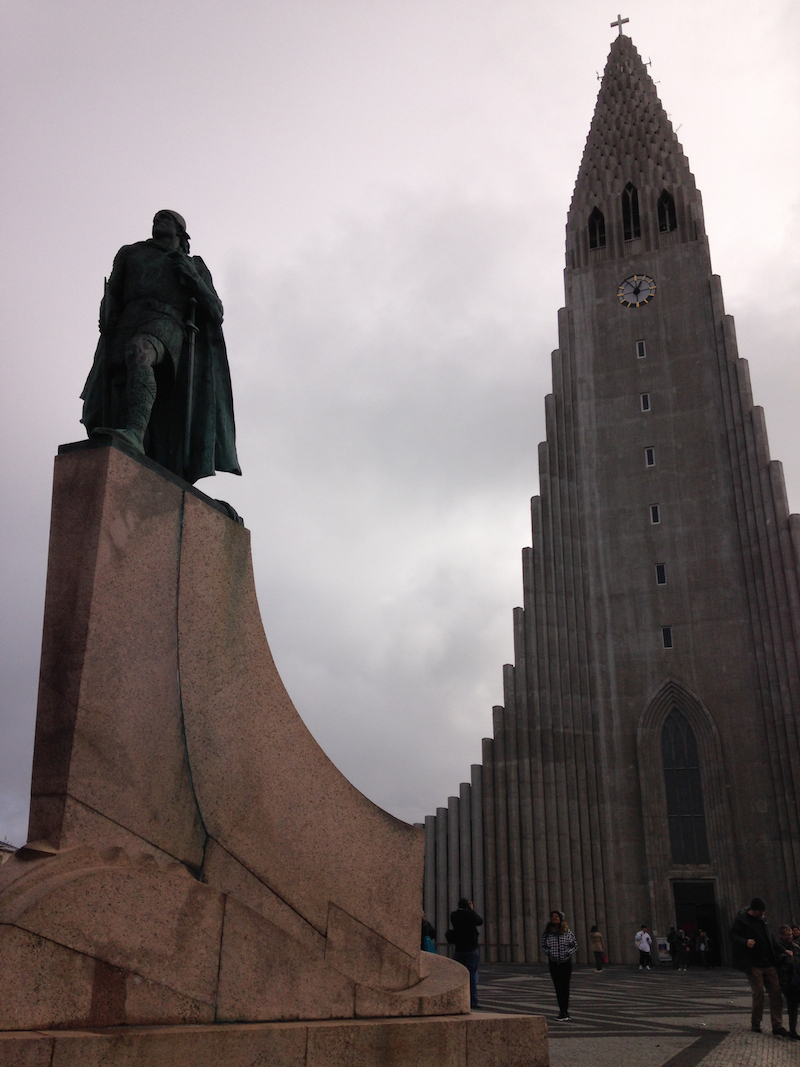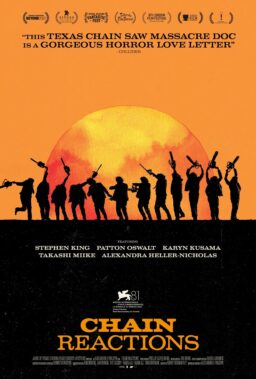“Mighty heartbeat of the ocean’s cold depths,
my strength and peace I drink from your sound.”
This except from the poem “Surf” can be found on a plaque near the statue of its author, Einar Benediktsson, in Iceland’s capital city, Reykjavík. Revered for his Neo-Romantic portrayal of natural wonders, the poet is immortalized in stone on the lawn of his former home, where presidents Ronald Reagan and Mikhail Gorbachev held their historic summit in 1986. Benediktsson’s monument is framed against a range of snow-capped mountains, the sheer awesomeness of which no picture could adequately capture. One of the most enticing aspects of the Reykjavík International Film Festival (RIFF), currently running through Sunday, October 7th, is inarguably the landscape itself. During my lengthy bus ride from the Keflavík airport to Reykjavík, I was struck by how the rugged, largely barren terrain still appeared to be untouched by man. On multiple occasions, I spotted what appeared to be human figures perched at the edge of cliffs. Only as they grew clearer in the misty, rain-drenched air did the figures reveal themselves to be nothing more than large rocks, with a small rock stacked on top of each. With its citizens numbering well below 350,000—the majority of which are located in the capital city—Iceland remains Europe’s most sparsely populated country, yet there is no lack of vibrant humanity in its culture.
Americans disillusioned by the current state of governmental affairs will likely find Icelandic society to be a welcome reprieve. It runs almost completely on renewable energy (my bus ride included), provides universal health care, has the strongest journalist protection law in the world and—most importantly—is almost entirely free of mosquitoes. The country’s support for environmental protection is embodied by its current prime minister, Katrín Jakobsdóttir, a member of the Left-Green Movement and the second female to serve in that position. Preceding her was Jóhanna Sigurðardóttir, the first-ever openly lesbian head of government, who amended Iceland’s marriage law to make it gender-neutral in 2010. Not only is Iceland’s highly approved president, Guðni Thorlacius Jóhannesson, well-schooled in history, he’s also famous for translating Stephen King books into the national dialect. The spiritual linkage between Reykjavík’s striking architecture and the prominent figures of its past is perhaps best expressed in the image posted above, showing how a statue of Norse explorer Leif Erikson blends seamlessly into Hallgrimskirkja Cathedral, a towering structure serving as the city’s North Star.

Kicking off the 15th installment of RIFF on September 27th was “Donbass,” a punishing yet vital work from Ukrainian filmmaker Sergey Loznitsa that seeks to illustrate how our current era of alternative facts has reduced everyday citizens to expendable extras in the celebrated stories of tyrants. The picture is particularly impressive in terms of its scope, as the narrative baton is passed from one character to the next in 13 plot threads that circle back to the beginning, like a snake engulfing its own tale. Since there is no central protagonist to become fully invested in, the film functions as less of a searing drama than an absurdist allegory about the escalating insanity in eastern Ukraine, as local nationalists clash with the Russian-backed Donetsk People’s Republic. The recurring theme of fake news materializes as sincerely delivered statements are repeatedly debunked as acts of political theater, such as when a man utilizes hastily placed items in a storeroom to prove that a hospital is fully stocked, only to be applauded after going “backstage” to the doctor’s office. There’s a “Catch-22” level of maddening surrealism to the sequence in which a poor guy tries to pick up his stolen car at a police station, only to be shamed and threatened into giving it up as a necessary sacrifice supporting the fight against fascism (“It’s not robbery, it’s expropriation,” the officer explains).
Time and again, the severing of an empathetic connection between strangers is magnified. A wealthy woman struggles to remove her mother out of a musty bomb shelter, less out of concern for her mother’s well-being than to avoid personal embarrassment, while referring to the surrounding impoverished inhabitants as “scum.” An old man branded a “Ukrainian exterminator” is publicly beaten with such unrelenting cruelty, one expects a lynching to break out, and it’s in moments like these where the camerawork is unflinching to the point of bordering on excruciating. Of course, the real star of the film is its Romanian DP, Oleg Mutu, one of the greatest living cinematographers, whose lensing fully immerses us in the characters’ plight, whether it be through a static wide shot or a snaking unbroken take (a prime example would be the intimate stroll through the labyrinthine bomb shelter). His sense of composition is impeccable, often building tension or crafting poignance by holding on the protagonist’s face in the midst of a crowd, such as the young woman seeking an illegal abortion in Cristian Mungiu’s Palme d’Or-winner “4 Months, 3 Weeks and 2 Days” or the girl dancing defiantly at her friend’s wedding in Nana Ekvtimishvili and Simon Gross’s masterpiece, “In Bloom.” Here, Mutu’s approach is more akin to the cinema of Michael Haneke, culminating with an 11-minute shot that serves as a fitting bookend, affirming the scripted nature of modern truth.

After enduring the horrors of “Donbass,” not to mention the icy temperatures one can easily weather when sightseeing, nothing could possibly offer more welcome relief than watching Luc Besson’s 1997 cult classic “The Fifth Element” from the comfort of a heated swimming pool. This is how I chose to end my first full day in Iceland on the evening of September 29th at Sundhöllin pool, and the experience was utterly euphoric, not in the least due to the film itself. Besson’s playful sci-fi fantasy is an ideal choice for such a venue because it is pure lightweight fun unencumbered by the self-important exposition that mars so many contemporary blockbusters. It isn’t beholden to any preexisting franchise or comic book, and therefore has the freedom to take risks without treating itself with the seriousness typically reserved for Biblical scripture. Besson’s film only pretends to be a cheesy bore at first, but as soon as its lovably nonchalant hero, Korben Dallas (Bruce Willis), enters the yarn, it makes no secret of the fact that it is, in essence, a full-on comedy in the vein of “The Princess Bride.” Each new character proves to be more uproariously outlandish than the last, from Milla Jovovich’s multipass-brandishing Leeloo and Gary Oldman’s twangy thug Zorg to Chris Tucker’s manic blur of a talk show host, who exclaims, “Bzzzt!”, as if his finger is perpetually stuck in an outlet.
Though the special effects never overwhelm the charm of the characters, Besson’s portrayal of airborne traffic interrupted by hurtling bodies is infinitely superior to their ripped-off variation in “Star Wars: Episode II—Attack of the Clones,” primarily because the universe crafted for “The Fifth Element” feels infinitely more lived-in. One of the most transcendent moments in ’90s cinema occurs when the blue-skinned Diva (voiced by Albanian soprano Inva Mula) sings a haunting aria that erupts into an exuberant fusion of hip-hop and opera, requiring her to hit notes so high, they would even prove formidable for “The Magic Flute”’s Queen of the Night. As the song reaches its climax, editor Sylvie Landra juxtaposes the Diva’s performance with Leeloo effortlessly taking on a roomful of goons with her fists. The sequence is such a timeless crowd-pleaser that it prompted the entire swimming pool to break out into thunderous, frothy applause. There’s no question the audience had been anticipating it, since the Diva’s vocals could also be heard over the speakers in the shower room, as a performer dressed as Korben Dallas jumped out at random swimmers, armed with a replica of Willis’ gun. Another performer dressed as Leeloo interacted with participants in the cavernous indoor pool area prior to the film playing on a full-sized theater screen, and there was even a robotic DJ wearing a silver skullcap evocative of Zorg’s plastic headpiece.
Many Icelandic locations were utilized for “The Fifth Element,” including the country’s largest ice cap, Vatnajökull, another potential reason why the film was selected for this year’s installment of the festival’s annual Swim-in-Cinema event. Besson would’ve undoubtedly been pleased with the screening, especially since he had originally intended on being a marine biologist (both of his parents were scuba diving instructors). Among the benefits of watching movies in a location this freeing is it gives audiences the opportunity to react not just with their guffaws and clapping hands, but with their entire bodies. Bad films will cause participants to amble distractedly around the water within minutes, so it’s a testament to “The Fifth Element”’s ageless appeal that for the entirety of its two-hour-plus running time, it left the crowded pool of moviegoers transfixed with delight.












